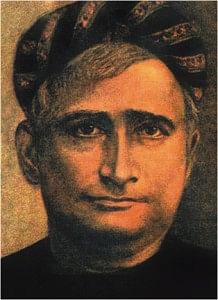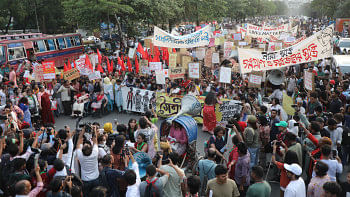Fostering a love of the Bengali language

Bankim Chandra Chattopadhyay is considered one of the greatest novelists of the sub-continent. The Bengali novel genre practically began with him. He is widely regarded as a key figure in literary renaissance of Bengal as well as undivided India. Some of his writings, including novels, essays and commentaries, were a breakaway from the traditional verse-oriented writings, and provided an inspiration for authors.
Yesterday marked the 172nd (June 27, 1838) birth anniversary of the litterateur.
Bankim Chandra was born in the village Kanthalpara in Naihati, in an orthodox Bengali Brahmin family, the youngest of three brothers, to Jadab Chandra Chattopadhyay and Durga Debi.
He was educated at the Mohsin College in Hooghly and later at the Presidency College, graduating with a degree in Arts in 1857. He was one of the first two graduates of the University of Calcutta. He later obtained a degree in Law as well, in 1869.
He was appointed as Deputy Collector of Jessore. Bankim Chandra went on to become a Deputy Magistrate, retiring from government service in 1891. His years at work were peppered with incidents that brought him into conflict with the ruling British. However, he was made a Companion, Order of the Indian Empire in 1894.
Following the model of Ishwarchandra Gupta, Bankim Chandra began his literary career as a writer of verse. He soon realised, however, that his talents lay in other directions, and turned to fiction. His first attempt was a novel in Bengali submitted for a declared prize. He did not win the prize, and the novelette was never published. His first fiction to appear in print was “Rajmohan's Wife.” It was written in English and was probably a translation of the novelette submitted for the prize. “Durgeshnondini,” his first Bengali romance and the first ever novel in the Bengali language, was published in 1865.
“Kapalkundala” (1866) is his first major publication. The heroine of this novel is modelled partly after Kalidasa's Shakuntala and partly after Shakespeare's Miranda. However, the partial similarities are only inferential analysis by critics, and Bankim Chandra's heroine may be completely original.
His next romance, “Mrinalini” (1869), marks his first attempt to set his story against a larger historical context. This book marks the shift from his early career, in which he was strictly a writer of romances, to a later period in which he aimed to stimulate the intellect of the Bengali speaking people and bring about a cultural renaissance of Bengali literature. He started publishing a monthly literary magazine “Bangodarshan.” The magazine carried serialised novels, stories, humorous sketches, historical and miscellaneous essays, informative articles, religious discourses, literary criticisms and reviews.
In “Krishnakanter Will” (Krishnakanta's Will, 1878) Bankim Chandra produced a complex plot. In that complexity, critics saw resemblance of Western novels.
His final novel, “Sitaram” (1886), tells the story of a local Hindu lord, torn between his wife and the woman he desires but unable to attain, making a series of blunders and taking arrogant, self-destructive decisions.
One of the aims of Bankim Chandra was to interest people in science and in the progress of the society and country. It was a time when educated Bengalis spoke only English instead of their own language. Bankim Chandra wanted to foster the love of the Bengali language in the educated Bengalis, and to make them share their knowledge with others through their language.
Bankim Chandra passed away on April 8, 1894.

 For all latest news, follow The Daily Star's Google News channel.
For all latest news, follow The Daily Star's Google News channel. 



Comments